Amalfi Coast Travel Guide
Graced with dramatic landscapes, crystalline waters and alluring old-world abodes, the Amalfi Coast is absolutely the quintessential Mediterranean getaway. Moneyed nobles relaxed here in the age of Ancient Rome, and the region's charms are just as irresistible today.
The idyllic destination lies between the towns of Positano and Vietri sul Mare, near Salerno, and the area is renowned for its rugged cliffs, romantic bays and lush foliage. Precariously perched and threatening to topple into the sea, the small town of Positano is a great attraction for tourists, with its cluster of multi-coloured houses and remarkable setting. A cliffside stairway provides the perfect vantage-point from which to admire its glorious sea vistas.
Four miles (6km) down the coast is the quaint town of Praiano. A stroll from here towards Amalfi will take visitors to a ramp leading to Marina di Praia, a 400-year-old fishing village nestled in the embrace of a tiny ravine. Another notable stop between Praiano and Amalfi is the Grotta dello Smeraldo (the Emerald Cave), which takes its name from the green light inside the cave. The effect is caused by natural sunlight from outside that enters the cave through an underground passage. The water filters the sunlight so that only green wavelengths reach the cave.
The busy seaside town of Amalfi basks in the glory of its history as the first Sea Republic of Italy, and as the hometown of Flavio Gioja, the inventor of the compass. It's referred to as the 'pearl of the coast' and has a bit of everything for the weary traveller. A pebble's throw away from here is the quiet village of Atrani, whose tranquil beach rests languidly on the water's edge against a superb backdrop of mountains.
Further down the coast is Minori, a small town that's popular with holidaying Italians, and is notable for its lemon exports, its festive seafront and atmospheric pedestrian shopping streets. The tranquil town of Ravello retains the charm prized by Renaissance author, Giovanni Boccaccio, who dedicated part of his famous work, the Decameron, to it.
A journey along this southern route of enchanting villages, bays and inlets will live long in the memory, and is a must for lovers of beauty and romance.
Things to do in Amalfi Coast
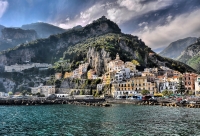
Amalfi
The town of Amalfi sits elegantly against a backdrop of steep cliffs and thickets of lemon trees. Terraced buildings climb down to the shoreline, their pastel hues enhancing the fairytale allure of this Italian seaside retreat. Amalfi was once one of the great maritime republics that thrived off trade and rivalries with Pisa, Genoa and Venice. The 9th-century Amalfi Cathedral is a breathtaking example of Arab-Norman Romanesque architecture, while museums include the fascinating Museo della Carta and the Arsenal of the Maritime Republic.
The Piazza del Duomo is the main hub, and is dotted with cafes, gorgeous boutiques and romantic restaurants. A promenade allows visitors to gaze over the picturesque marina and beyond to the memorable emerald waters. The main beach is the sheltered Marina Grande, with sandier beaches found at the villages of Minori and Maiori.
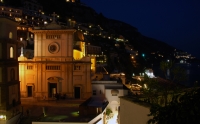
Positano
Positano retains the authentic character that endeared it to artists and writers such as Picasso, Escher and Steinbeck. Pastel-coloured houses and bougainvillea-draped hotels are connected by steep roads and steps to a boat-filled harbour below. In the town centre is the cobbled Flavio Gioia Square, which is surrounded by boutiques, bars and restaurants. Rising above is the 11th-century Basilica di Santa Maria Assunta, with its beautiful golden dome. There are two main beaches in Positano. Just below the town centre, Spiaggia Grande's expanse of dark sand is packed with deckchairs and sunbathers, while Spiaggia del Fornillo is a ten-minute stroll from the centre. There are also lovely hiking trails found in the surrounding Monti Lattari mountain range. Sorrento and Amalfi are short drives away, and there is a daily ferry to Capri from the harbour.
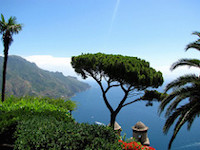
Ravello
Typical of the picturesque towns along the Amalfi Coast, the small hilltop village of Ravello clings to the coastal foothills and steep rocky cliffs above the town of Amalfi. Houses climb slopes green with olive trees and lemon orchards, while emerald waves lap against the sands of Castiglione Beach.
Its views are some of the best in the Mediterranean, with famous American writer Gore Vidal praising the vistas from his perch at the classically stunning Villa Cimbrone. Here, visitors can explore its gardens and vineyards, as well as gaze out from the famous Terrace of Infinity.
Villa Rufolo serves as the unofficial town centre, its centuries-old windows and domed towers looking out onto the cathedral square. Ravello cuisine is dominated by white wine and fresh ingredients found in the hills above or the waves below, offering pasta, pizza and gelato, and a host of dishes containing the area's famous lemons and limoncello, a lemon liqueur.
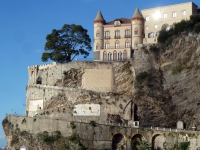
Maiori and Minori
Maiori may lack the glamour and crowds of its more famous neighbours, but is famous for having one of the largest beaches on the Amalfi Coast. The beachfront hotels make Maiori ideal for those who love the sea, while the dominating Castle of San Nicola de Thoro Plano and the fishing town's long history means there's plenty to discover and explore.
Maiori is a great spot for foodies, and some wonderful restaurants line the promenade and the main street, Corsa Reginna. Depending on the time of day, visitors can enjoy a cappuccino, gelato or the locally produced limoncello liqueur. The tiny nearby town of Minori basks in history, being the oldest town on the Amalfi Coast. It has numerous historic sites, most notably a 1st-century Roman maritime villa.
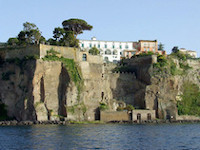
Sorrento
Sorrento is a sophisticated seaside resort in the heart of the Neapolitan Riviera, its lively bars, enticing restaurants and chic boutiques remaining popular among the world's travellers season after season. The town is perched on a cliff that overlooks glorious azure waters, where visitors will find some good diving and great sea fishing. Boat cruises are also available.
Although there's a small beach at the harbour, most bathers swim off the rocks or from wooden jetties, or laze around their hotel swimming pool, enjoying the stunning views of Naples and Mount Vesuvius. Sorrento is a popular base for exploring the local area. It's an hour's drive from Naples and a short distance from the gorgeous towns of Amalfi and Positano. Many visitors will also make a boat trip to the island of Capri, the mythical home of the Sirens, or travel by train to the ruins of Pompeii.
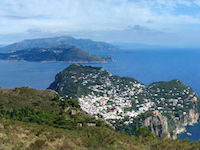
Capri
Capri has long been a favoured destination for celebrities and the megarich. Believed to be Homer's mythical land of the Sirens, it was once home to Emperor Tiberius, who ruled from his clifftop villa. The island is now most famous for its dramatic landscape, upmarket hotels and the expensive boutiques and restaurants.
Travellers can escape the crowds by heading up Mount Salero, an hour or two's walk or a 12-minute ride on a chairlift. A boat trip is also a wonderful way to enjoy the island. Most tours stop at the famous Blue Grotto, where visitors pass through the caves in small rowing boats. Capri sits in Italy's Bay of Naples, and is a popular day trip from Sorrento and Positano.
Italy travel info
Electricity
Electrical current in Italy is 230 volts, 50Hz. A variety of plugs are in use, including the European-style two-pin plug.
Language
The official language of Italy is Italian. English is understood in the larger cities but not in the more remote parts of the country.
Money
The euro (EUR) is the official currency, which is divided into 100 cents. Those arriving in Italy with foreign currency can obtain euros through any bank, ATM or bureau de change. ATMs are widespread; credit cards are accepted in upmarket establishments and shops around the cities. Banks are closed on weekends but tend to have better rates than foreign exchange houses.
Tipping
Tipping is customary in Italy and 10 to 15 percent of the bill is acceptable in restaurants, unless a 15 percent service charge has already been added to the bill. Hotels add a service charge of 15 to 18 percent, but it is customary to tip the service staff extra. Italians rarely tip taxi drivers but a 5 to 10 percent tip is always appreciated.
Health
There are no specific health risks associated with travel to Italy and visitors should be able to travel without special vaccinations and medications. Medical facilities in Italy are good but travel insurance is still recommended for non-EU citizens, as medical attention can be expensive. EU citizens can make use of Italy's health services provided they have a European Health Insurance Card (EHIC), with UK citizens using their Global Health Insurance Card (GHIC). The GHIC replaced the EHIC for UK citizens and allows UK citizens access to state healthcare during visits to the EU. The GHIC is not valid in Norway, Iceland, Liechtenstein or Switzerland, nor is it an alternative to travel insurance. Although it should be possible to get most medication in Italy, travel authorities always suggest taking any prescribed medication in its original packaging with a signed and dated letter from a doctor.
Safety
Tourists are vulnerable to pickpocketing in the bigger cities, particularly on public transport, in crowded areas and around tourist sites. It's advisable to be careful when carrying large amounts of cash and valuables. Travellers should be particularly careful around Termini, which is the main train station in Rome. Visitors should be wary of groups of children, some of whom will distract attention while the others try to steal what they can. Strikes by transport workers take place regularly throughout Italy and delays are possible.
Local customs
In Italy, it's an offence to sit on steps and in courtyards near public buildings, including the main churches in Florence; eating and drinking in the vicinity should also be avoided. Shorts, vests or any other immodest clothing should not be worn inside churches.
Doing business
Italians can be very formal and old fashioned, but are also warm and welcoming. Face to face communication is best and often a third party introduction can speed initial negotiations. Business attire is formal and stylish, and handshakes are the norm, with first impressions counting a lot in Italy. Business cards are used. Visiting business people should also expect plenty of gesticulating, interruptions or people talking over each other. Unfortunately the bureaucracy in Italy can slow down deal-making. Business hours are usually 9am to 5pm Monday to Friday, but can vary according to season and region.
Duty free
Travellers over 17 years from non-EU countries do not have to pay duty on 200 cigarettes, 50 cigars or 250g of tobacco. Nor do they have to pay duty on 4 litres of wine, 16 lires of beer or 1 litre of spirits over 22 percent volume, or 2 litres of alcoholic beverages less than 22 percent volume. Other goods up to the value of €430 are also permitted (reduced to €175 for children under 15).
Travellers from EU countries travelling within the EU are limited to 110 litres of beer, 90 litres of wine, 10 litres of fortified wine, 10 litres of spirits and 1kg of tobacco, 800 cigarettes, 200 cigars or 400 cigarellos. Prohibited items include narcotic drugs, medicinal products, arms and weapons, explosives and protected animal and plant species.
Communications
The international access code for Italy is +39. Hotels, cafes and restaurants offering free WiFi are widely available; as international roaming costs can be high, purchasing a local prepaid SIM card can be a cheaper option.
Passport & Visa
The borderless region known as the Schengen Area includes the following countries: Austria, Belgium, Czech Republic, Denmark, Estonia, Finland, France, Germany, Greece, Hungary, Iceland, Italy, Latvia, Lithuania, Luxembourg, Malta, The Netherlands, Norway, Poland, Portugal, Slovakia, Slovenia, Spain, Sweden and Switzerland. All these countries issue a standard Schengen visa that has a multiple entry option, and which allows the holder to travel freely within the borders of all the aforementioned countries. All foreign passengers to Italy must also hold visible proof of financial means to support themselves while in the country, return or onward tickets, and the necessary travel documentation for their next destination. Visitors may be refused entry, either for public security, tranquillity, order or health reasons. Extensions of stay in Italy are possible by applying to local authorities. It is highly recommended that travellers' passport have at least six months' validity remaining after the intended date of departure from their travel destination. Immigration officials often apply different rules to those stated by travel agents and official sources.
Entry requirements
US citizens must have a passport that is valid for at least three months beyond their intended stay in Italy. No visa is required for stays of up to 90 days within a 180 day period.
UK citizens must have a passport that is valid for at least three months beyond their intended stay in Italy. No visa is required for stays of up to 90 days within a 180 day period.
Canadian citizens must have a passport that is valid for at least three months beyond their intended stay in Italy. No visa is required for stays of up to 90 days within a 180 day period.
Australian citizens must have a passport that is valid for three months beyond their intended stay in Italy. No visa is required for stays of up to 90 days within a 180 day period.
South African citizens must have a passport that is valid for three months beyond their intended stay, and a valid Schengen visa, to enter Italy.
Irish citizens must have a passport that is valid upon their arrival in Italy. No visa is required.
New Zealand citizens must have a passports valid for three months beyond period of intended stay in Italy. No visa is required for stays of up to 90 days within a 180 day period.
Useful contacts
www.enit.it
112 (General Emergencies), 113 (Police), 118 (Ambulance)Embassies / consulates in other countries
Italian Embassy, Washington DC, United States: +1 202 612 4400.
Italian Embassy, London, United Kingdom: +44 (0)20 7312 2200.
Italian Embassy, Ottawa, Canada: +1 613 232 2401.
Italian Embassy, Canberra, Australia: +61 (0)2 6273 3333.
Italian Embassy, Pretoria, South Africa: +27 (0)12 423 000.
Italian Embassy, Dublin, Ireland: +353 (0)1 660 1744.
Italian Embassy, Wellington, New Zealand: +64 (0)4 473 5339.
Embassies / consulates in Italy
United States Embassy, Rome: +39 06 46741.
British Embassy, Rome: +39 06 4220 0001/ 4220.
Canadian Embassy, Rome: +39 06 85444 2911.
Australian Embassy, Rome: +39 06 852 721.
South African Embassy, Rome: +39 06 852 541.
Irish Embassy, Rome: +39 06 585 2381.
New Zealand Embassy, Rome: +39 06 853 7501.



